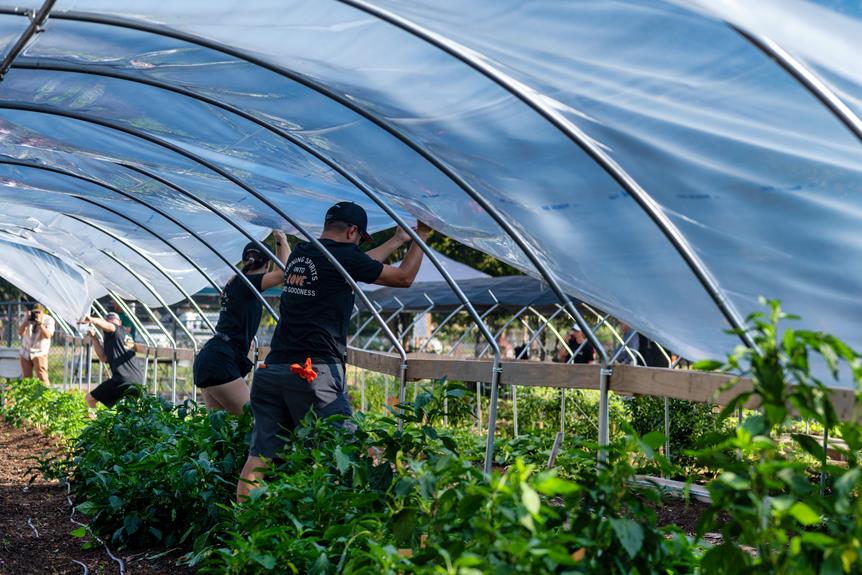Rampant Injuries Plague Poultry Plants – Workers’ Comp at Stake
This article explores the high incidence of injuries in poultry processing plants, highlighting the critical role of workers' compensation. It delves into the complexity of proving work-related injuries, procedures for filing claims, and the significance of legal consultation. The piece also introduces Lawsuit Legit resources for legal support, emphasizing the necessity for comprehensive understanding of health and safety issues in this high-risk industry.

Key Takeaways
- Poultry plant workers suffer more injuries than the average person.
- Workers compensation provides insurance for injured workers, but proving injuries that happen over time can be challenging.
- Poultry processing injuries can include repetitive motion injuries, slip-and-fall injuries, heavy lifting injuries, and biohazard-induced illnesses.
- Workers compensation benefits can include medical treatment costs, lost wages, transportation to medical appointments, and job retraining.
Understanding the Poultry Processing Industry
In our current discussion on understanding the Poultry Processing Industry, it's imperative to acknowledge the associated occupational hazards and the vital role of workers' compensation in addressing injuries sustained in this high-risk sector. The poultry industry working conditions are often fraught with risks, including repetitive stress injuries, exposure to biohazards, and potential for accidents due to slippery floors or heavy lifting. Ensuring worker safety measures in poultry processing is, therefore, critical. These measures include adequate training, provision of protective equipment, regular health and safety audits, and implementation of ergonomically-designed workstations. However, despite preventative measures, injuries do occur. In such scenarios, workers' compensation plays a crucial role, providing financial support and access to necessary medical care, thus underscoring its importance in this industry.
The Prevalence of Injuries in Poultry Plants
Alarmingly often, employees in poultry plants report injuries, underlining the urgent need for improved safety measures and robust workers' compensation policies. Preventing injuries in poultry plants has become a pressing issue, with a high prevalence of repetitive strain injuries, slip-and-fall incidents, and biohazard-induced illnesses. The key to improving worker safety in poultry processing lies in comprehensive changes, including enhanced training, better equipment, and stricter enforcement of safety regulations. Furthermore, employers must ensure their workers' compensation policies are sufficient to cover the medical costs, lost wages, and rehabilitation services associated with these injuries. Delving into the complexity of these health and safety issues, it becomes clear that multi-faceted solutions are required to protect the wellbeing of these essential workers.
The Role of Workers’ Compensation in Poultry Plants
Nearly all poultry plant workers rely heavily on workers' compensation to cover the financial burdens imposed by injuries and illnesses incurred on the job. However, the importance of worker safety in poultry plants often ends up overshadowed by productivity demands. Workers face substantial challenges in obtaining compensation for their injuries, with claims often disputed due to the difficulty of proving that injuries were job-related. Repetitive strain injuries, common in this industry, are particularly challenging to substantiate. Enhancing worker safety in poultry plants can reduce injury rates, lessen the reliance on workers' compensation, and improve overall worker wellbeing. A multi-faceted approach, including preventative measures, adequate training, and fair compensation policies, is crucial to address this pervasive issue.
The Complexity of Proving Work-Related Injuries
Navigating through the intricacies of proving work-related injuries, which is an essential step towards securing workers' compensation benefits, becomes especially complex when dealing with conditions such as repetitive strain injuries that develop gradually over time and do not result from a specific incident. The challenges in proving cumulative injuries are manifold, often requiring substantial medical documentation and expert testimony to establish a direct causal link to the workplace. The importance of documenting workplace incidents cannot be overstated as it forms a crucial part of the evidence chain. Such meticulous record-keeping aids in establishing a pattern of exposure to risk factors, thereby strengthening the claim. Thus, understanding the nuanced requirements of proving such injuries is paramount for workers seeking compensation.
Common Injuries Sustained in Poultry Processing Plants
Repetitive strain injuries and slip-and-fall incidents are among the most common injuries sustained in poultry processing plants, both of which can result in significant health and financial repercussions for the affected workers. These injuries often stem from conditions of slippery floors, rapid repetitive motions, and heavy lifting. A focused approach towards preventing workplace injuries, is therefore, of utmost importance. Improving safety measures, such as better equipment design, improved working conditions, and more effective training programs can significantly mitigate these risks. Furthermore, thorough and ongoing risk assessments are imperative. Employers should also foster a culture of safety where workers are encouraged to report unsafe conditions. By prioritizing worker safety, these plants can substantially reduce the prevalence of these debilitating injuries.
The Impact of Biohazards and Chemical Exposure in Poultry Plants
The exposure to biohazards and hazardous chemicals in poultry plants continues to pose significant health risks to employees, contributing to a range of illnesses and conditions that can severely impact their quality of life. Research is increasingly highlighting the long-term health effects of biohazards and chemical exposure in poultry plants, with some studies linking these conditions to chronic respiratory disorders, skin diseases, and even certain types of cancer. Despite the mounting evidence, however, there are concerns that not enough is being done to mitigate these risks. The responsibility of employers in preventing biohazard and chemical exposure in poultry plants is paramount. This includes implementing robust safety protocols, providing appropriate protective gear, and regularly educating employees about potential hazards and prevention measures.
The Scope of Workers’ Compensation Benefits
Why are workers' compensation benefits critically important for poultry plant workers who suffer from injuries and illnesses, and how can these benefits contribute to their recovery and financial stability? These benefits are a lifeline, covering medical treatment costs, lost wages, and disability payments during recovery. Given the high injury rates in the poultry industry, these benefits are significant. They provide financial stability and facilitate recovery, allowing workers to focus on regaining health rather than worrying about bills. The importance of prevention strategies cannot be overstated, as reducing injuries reduces the need for compensation claims. Furthermore, the role of employer responsibility is vital. Employers must ensure safe working conditions, and when injuries do occur, they should accommodate workers' compensation claims promptly and fairly.
The Process of Medical Treatment Coverage
Given that medical treatment forms a substantial part of workers' compensation benefits, understanding the process of medical treatment coverage becomes imperative, especially when dealing with the financial implications of workplace injuries in the poultry industry. The process includes initial diagnosis, treatment planning, and ongoing care, all of which can be complex and costly. Workers often face challenges in proving work related injuries, particularly in cases of repetitive strain or biohazard-induced illnesses. Furthermore, the financial burden is not just immediate medical costs; it includes future therapies and loss of earnings during recovery. Therefore, it is crucial to understand the extent of medical treatment coverage under workers' compensation, to ensure that injured workers in poultry processing facilities receive the comprehensive support they are entitled to.
The Provision of Lost Wages and Disability Payments
In addition to covering medical expenses, workers' compensation also provides for lost wages and disability payments, ensuring that injured poultry processing workers can financially sustain themselves during their period of recovery. This is a crucial aspect in the overall compensation process, as it allows employees to focus on their recovery instead of worrying about the financial burden. The importance of workplace safety training cannot be overstated in this context, as it equips workers with the necessary knowledge to prevent injuries. Employers play a significant role in preventing injuries in the workplace by ensuring proper training and maintaining safety standards. Adequate workers' compensation, combined with a strong emphasis on safety training, can mitigate the financial and emotional impact of workplace injuries.
The Procedure to File a Workers’ Compensation Claim
Filing a workers' compensation claim involves a precise process, starting with promptly reporting the injury to your employer and seeking immediate medical attention. Understanding the importance of reporting injuries promptly cannot be overemphasized, as it not only accelerates the treatment process but also establishes a record of the incident. This record serves as crucial evidence when navigating the complexities of the workers' compensation system. However, the challenges of navigating this system can be daunting, particularly given the intricate nature of the rules governing it. These rules often require comprehensive documentation, legal expertise, and an understanding of the specific nuances related to injuries in the poultry industry. As such, workers should consider seeking professional support to ensure their claim is effectively handled.
The Significance of Legal Consultation for Injury Claims
Understanding the complexities of workers' compensation claims, particularly for poultry plant workers, underlines the importance of professional legal consultation, which aids in navigating the legal landscape for injury claims. The nature of poultry plant work often results in injuries, both immediate and long term. Proving these injuries and their relation to the workplace can be arduous. Expert legal representation becomes vital to comprehensively navigate the workers' compensation system. Legal counsel can provide strategic advice, ensuring that all medical reports, witness statements, and other evidence are meticulously compiled. They can also assist in determining the suitability of a claim, given the specific circumstances. Ultimately, the importance of legal representation in these cases cannot be overstated, as it significantly improves the chances of a successful claim.
Utilizing Lawsuit Legit Resources for Legal Support and Information
Leveraging the comprehensive resources provided by Lawsuit Legit can greatly enhance one's knowledge and understanding, thereby offering substantial support in navigating the intricate labyrinth of workers' compensation claims. Lawsuit Legit legal resources, designed with meticulous research and objective reporting, provide clear explanations of complex health and safety issues. These resources are particularly beneficial for workers in high-risk industries, such as poultry processing, where injuries are alarmingly prevalent. Lawsuit Legit acts as a vital conduit for finding top rated lawyers, ensuring individuals get the expert legal advice they require. By utilizing the platform's wealth of information, users can gain a deeper understanding of their rights, comprehend the complexities of workers' compensation claims, and ultimately secure fair compensation for their injuries. Thus, Lawsuit Legit is instrumental in empowering individuals navigating the complex legal terrain.
Frequently Asked Questions
How Does the Rate of Injury in Poultry Processing Compare to Other Meat Processing Industries?”
Injury statistics reveal a concerning trend in the poultry processing industry. Comparative analysis indicates that workers in these plants experience a higher rate of injuries compared to other meat processing industries. This disparity can be attributed to the unique working conditions in poultry plants, including the high-speed processing lines and repetitive nature of tasks, which increase the risk of both acute injuries and long-term musculoskeletal disorders. Such trends necessitate further investigation into workplace safety protocols within the industry.
What Are Some Preventative Measures Poultry Processing Plants Can Take to Reduce the Incidence of Injuries?”
To reduce injury incidence in poultry processing plants, implementation of preventative measures is crucial. These include ergonomics training, which educates workers on maintaining proper body mechanics during labor-intensive tasks, minimizing the risk of repetitive strain injuries. Additionally, provision and mandatory use of appropriate safety equipment can protect workers from hazards such as sharp tools, slippery floors, and harmful chemicals. Regular inspection and maintenance of this equipment is equally important to ensure its efficacy.
Are There Any Support Groups or Organizations Specifically Dedicated to Injured Poultry Plant Workers?”
Union advocacy groups play a crucial role in providing support to injured poultry plant workers. They assist in navigating the complex workers' compensation challenges and ensure fair treatment. Organizations like the United Food and Commercial Workers International Union (UFCW) offer resources, legal aid, and advocate for safer working conditions. Additionally, non-profit groups like the National Council for Occupational Safety and Health focus on promoting worker safety, thus providing an additional layer of support.
What Are the Psychological Impacts of Injuries in Poultry Processing Plants?”
Injuries in poultry processing plants can lead to significant psychological impacts, including stress, anxiety, and depression. The stigmatization of injury can exacerbate these effects, as workers may face social isolation or discrimination. Access to mental health services is crucial to support employees' psychological well-being. Such services can provide coping strategies, therapeutic support, and potentially mitigate the negative mental health impacts of workplace injuries.
How Do Poultry Processing Injuries Impact the Overall Supply Chain and Economy?”
Injuries in poultry processing not only affect the workers but also disrupt the supply chain and economy. Increase in workers' compensation claims can financially strain companies, potentially leading to reduced output or layoffs. Furthermore, the economic burden extends to healthcare costs and loss in productivity. Technological solutions could mitigate these injuries, improving worker safety, maintaining production levels, and hence, stabilizing the economic impact.
Conclusion
In conclusion, the poultry processing industry is fraught with occupational hazards, making workers' compensation insurance crucial. Navigating through the intricacies of proving work-related injuries and filing claims can be challenging. Therefore, legal consultation is indispensable. Resources from Lawsuit Legit can be instrumental in connecting workers with proficient lawyers and additional support, thus ensuring their rights are upheld and they receive the compensation they deserve.

This post has been generated by AI and was not reviewed by editors. This is Not legal advice. Please consult with an attorney.




